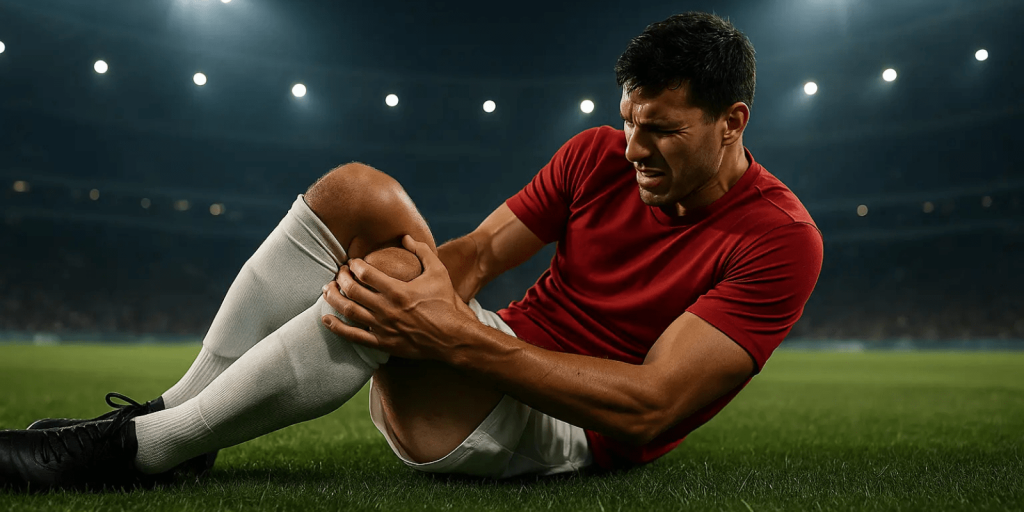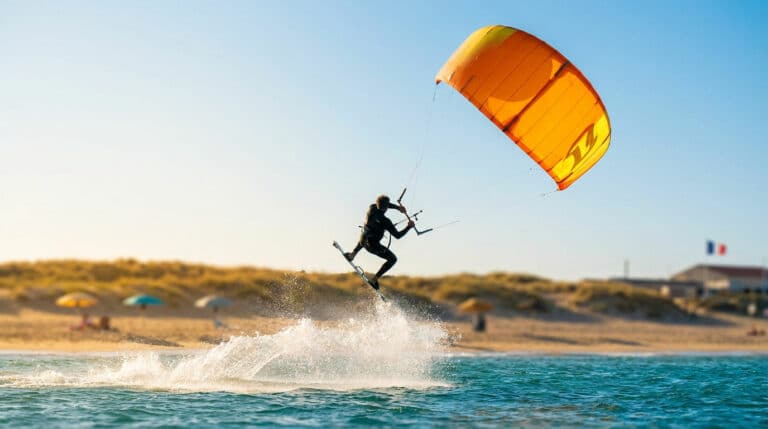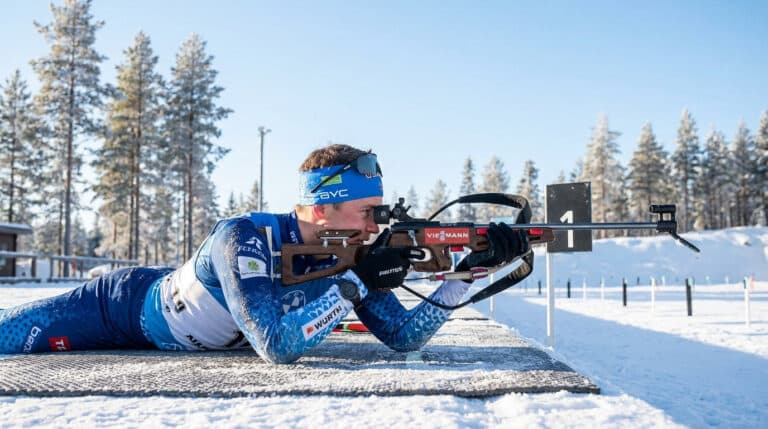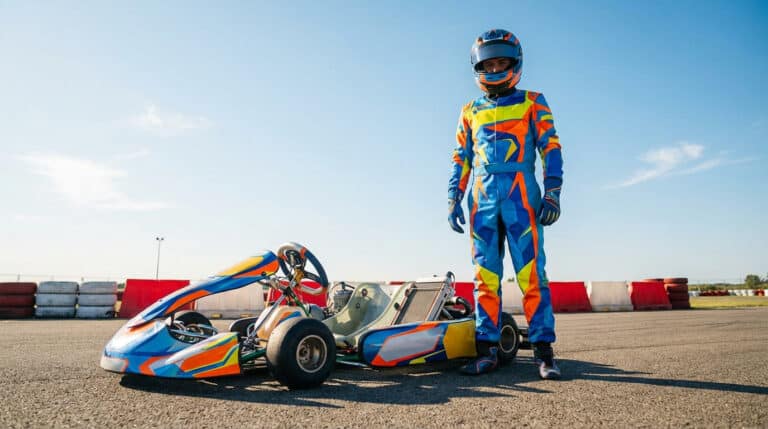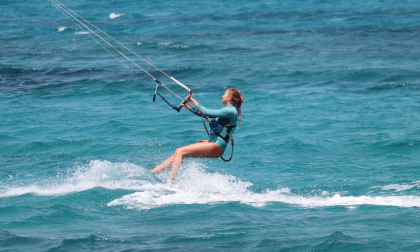87.6% of professional football players have suffered a major football injury, according to a Brazilian study, with 49.1% of incidents occurring during training and 67.8% being indirect mechanisms. Whether you’re an amateur or a professional, this guide reveals the secrets to countering muscle injuries (hamstrings, thighs) and joint injuries (ACL, ankle sprain), concussions, or chronic aftereffects. Discover exclusive data on causes, shocking stats (£45M/season cost in England), and scientifically validated prevention protocols that halve the risks. Transform your approach to football injuries with strategies proven by experts.
Football: a popular sport but high injury risk
Football is one of the most practised sports in France, with 1.7 million licensed players. It brings together fans and families around teamwork and perseverance. Yet this intense activity exposes players to unavoidable risks.
A Brazilian study found that 87.6% of professional players have suffered at least one injury during their career. But amateurs are also affected: out of 509,371 matches analysed in France between 2018–2019, the risk of injury was 0.57 per match — and rises with competition level.
The causes? Repeated contact, tackles, intense efforts, and fatigue. Around 49.1% of injuries occur during training, often linked to overload or technical mistakes. Severity varies: some limit activity temporarily, others require months off. Among professionals, 50.9% of injuries are classified as severe.
Understanding these risks is key to adopting preventive habits. Programmes such as FIFA 11+ reduce injuries by 30%. Better recovery management and targeted warm-ups help limit consequences, even for amateurs. The key? Prevent to preserve your passion without compromising your health.
What are the main causes of football injuries?
Direct and indirect trauma
Football injuries fall into two categories: direct and indirect trauma. The former results from external impact, such as tackles, collisions, or falls. These often cause bruises, fractures, or cuts. Indirect trauma, which accounts for 67.8% of cases according to a Brazilian study, occurs without contact, following a poorly executed movement — a sudden twist, sprint, jump, or kick. These cause muscle (strain, tear) or ligament (sprain) injuries, often in the thigh or knee. For instance, a sudden change of direction can cause an anterior cruciate ligament (ACL) rupture, while poor foot placement when running can result in a hamstring tear.
Aggravating risk factors
Several elements increase the likelihood of injuries. Overtraining fatigues the muscles and reduces coordination, increasing risks of falls or missteps. Poor physical preparation leads to muscular imbalances, such as a stronger quadriceps compared to weaker hamstrings. Previous injuries weaken already affected areas, especially with premature return to play. External factors like unsuitable footwear or slippery fields also disturb stability and support, causing indirect trauma. For example, studs not suited to artificial grass can create excessive twisting forces, raising the risk of knee ligament injuries. Data shows that 59% of football injuries occur without contact, often linked to fatigue or poor technique.
The most common football injuries
Lower limbs: the most exposed area
Lower limbs account for 30.4% of muscle injuries in football. Ankle sprains occur during sudden changes of support or tackles, affecting the lateral ligaments in 95% of cases. Symptoms include pain, swelling, and instability, with downtime ranging from 2 to 6 weeks.
Muscle injuries mainly affect the thigh. The hamstrings are especially vulnerable, with varying degrees of severity: strain (minor stretching), partial tear, or full rupture. Rest time ranges from 3 to 8 weeks depending on the extent.
Anterior cruciate ligament (ACL) rupture is a severe knee injury. It often occurs without contact (70–80% of cases) during twists with the foot fixed. Symptoms include a cracking sound, rapid swelling, and major instability. Post-surgery recovery takes 6–9 months.
Groin strain (pubalgia), caused by repeated microtrauma, affects the groin and pubic region. It often stems from muscle imbalances, particularly a lack of oblique abdominal reinforcement. Recovery can take several weeks to months.
Upper body and head
Shoulder and collarbone injuries often occur from falls on the upper limb. Acromioclavicular dislocations cause a visible “piano key” elevation of the collarbone. Clavicle fractures typically require around 2 months off.
Concussions occur after head impacts, especially during aerial duels. They require strict protocols: 48h of rest, followed by gradual return under medical supervision. Symptoms include headache, dizziness, and confusion.
| Type of injury | Affected area | Main symptoms | Indicative downtime |
|---|---|---|---|
| Ankle sprain | Ankle (ligaments) | Pain, swelling (“pigeon egg”), instability | 2–6 weeks |
| Muscle injury (tear) | Thigh (hamstrings, quadriceps), calf | Sharp pain (“stab-like”), bruise | 3–8 weeks |
| ACL rupture | Knee (ligament) | Cracking sound, rapid swelling, major instability | 6–9 months (post-surgery) |
| Groin strain (pubalgia) | Groin / pubis | Progressive pain during effort, radiating | Several weeks to months |
| Concussion | Head | Headache, dizziness, nausea, confusion | 1–4 weeks (depending on protocol) |
How to effectively prevent football injuries?
A holistic approach combining physical preparation, lifestyle habits, and effort management reduces risks from contact, tackles, and intense play. The FIFA 10+ programme (scientifically proven) cuts serious injuries by 30–50% through structured warm-ups.
Physical preparation: the cornerstone of prevention
Targeted preparation limits muscular or joint injuries. FIFA 10+ includes progressive warm-ups, muscle strengthening, and proprioception work. For example, balance board or Bosu exercises strengthen ankles and knees, reducing sprains. Core exercises stabilise the trunk, while squats build thighs, preventing imbalances. A Brazilian study shows that 87.6% of pro players suffered injuries, often linked to poor preparation.
Lifestyle and effort management
The 4 pillars of daily prevention:
- Hydration: 500 ml of water 2 hours before effort, then small sips every 15–20 min. Electrolytes help replace lost minerals.
- Nutrition: A balanced diet provides proteins and complex carbs for muscle repair. Fruits and vegetables supply antioxidants.
- Sleep: 7–9 hours per night for optimal recovery. Lack of sleep increases technical errors and falls.
- Listening to your body: Detecting fatigue signals prevents overtraining, responsible for 29% of match injuries.
Proper equipment (boots, shin guards) and alternating intense/rest sessions complete prevention. According to FIFA, personalised monitoring and balanced training sessions reduce long absences. While zero risk doesn’t exist, these practices reduce the impact — especially for the 50.9% of players affected by severe injuries.
Injury management: from diagnosis to return to play
First aid: the right reflex
In case of an acute on-field injury, the RICE protocol (Rest, Ice, Compression, Elevation) remains the gold standard. Easy to apply, it limits damage and accelerates recovery.
- Rest: Stop activity immediately to prevent worsening the injury. Even mild pain may hide severity.
- Ice: Apply cold (15–20 minutes) to reduce inflammation. Always use a cloth barrier to protect skin.
- Compression: Use an elastic bandage to limit swelling, without restricting circulation.
- Elevation: Keep the injured limb above heart level to drain fluids.
Though crucial, this protocol doesn’t replace medical consultation. Sprains or tears must be examined to rule out fractures or ligament ruptures.
Recovery and reathletisation
After first aid, structured medical follow-up is vital for a safe comeback.
- Medical diagnosis: Sports doctors use anamnesis and imaging (ultrasound, MRI) to identify the injury type. A moderate quadriceps tear needs precise evaluation to avoid relapse.
- Treatment: Most injuries heal with rehabilitation (stretching, muscle strengthening). Severe cases like ACL ruptures require surgery and long recovery.
- Reathletisation: Key phase to regain performance. Supervised by physiotherapists and trainers, it includes progressive drills (footwork, direction changes) to reacclimate the body. Cold baths and massages help optimise muscle recovery and prevent recurrence.
On average, a mild strain requires 15 days off, versus 5 weeks for a severe tear. Patience is key for a lasting comeback.
Beyond the physical: psychological impact and long-term effects
Mental recovery: the player’s hidden battle
A football injury affects the mind as much as the body. Frustration, isolation, and fear of losing form are common. Players go through emotional stages (shock, anger, depression, acceptance) that require active support. Losing daily routines (training, matches, team dynamics) amplifies these reactions.
- Set goals: Define achievable milestones (e.g., regaining specific technical movements) to measure progress weekly.
- Stay connected: Attend training, debriefs, or matches to maintain team bonds and motivation.
- Visualise recovery: Mentally rehearse successful actions (dribbles, passes, shots) to sustain confidence and technique.
- Seek support: Regularly talk with medical staff, coaches, or sports psychologists to manage stress and avoid premature return.
These strategies help rebuild confidence. Mindfulness exercises focused on breathing or concentration enhance rehabilitation effectiveness.
Chronic injuries and aftereffects
Early-onset osteoarthritis affects 33% of former pros before age 45 (vs 8–13% in the general population), often in the knee (34%) or ankle. Repeated head impacts during headers also increase the risk of neurodegenerative diseases such as CTE (chronic traumatic encephalopathy).
Pain and limitations: 90% of ex-players report moderate pain (65% with reduced mobility, 37% with anxiety or depression).
Adaptation is key: regular muscle reinforcement and adjusted intensity allow longer play. Personalised medical follow-up (exams, preventive exercises) remains vital for long-term health, especially after serious ligament injuries.
In conclusion, while football is thrilling, it carries frequent injury risks for all players. Rigorous physical preparation, healthy lifestyle habits, and prompt medical attention are essential. Prevention and vigilance remain crucial to protect both amateur and professional players’ health.
